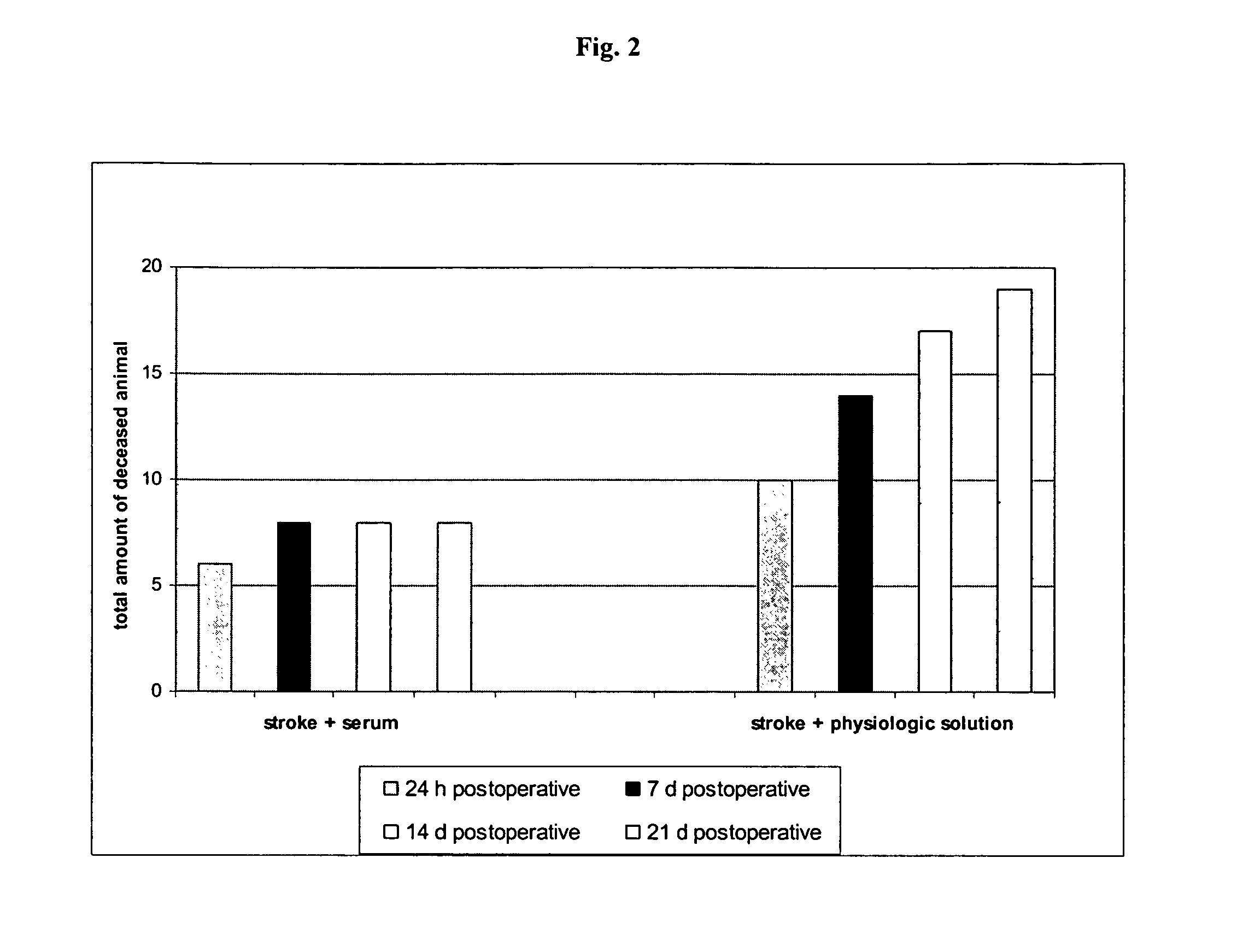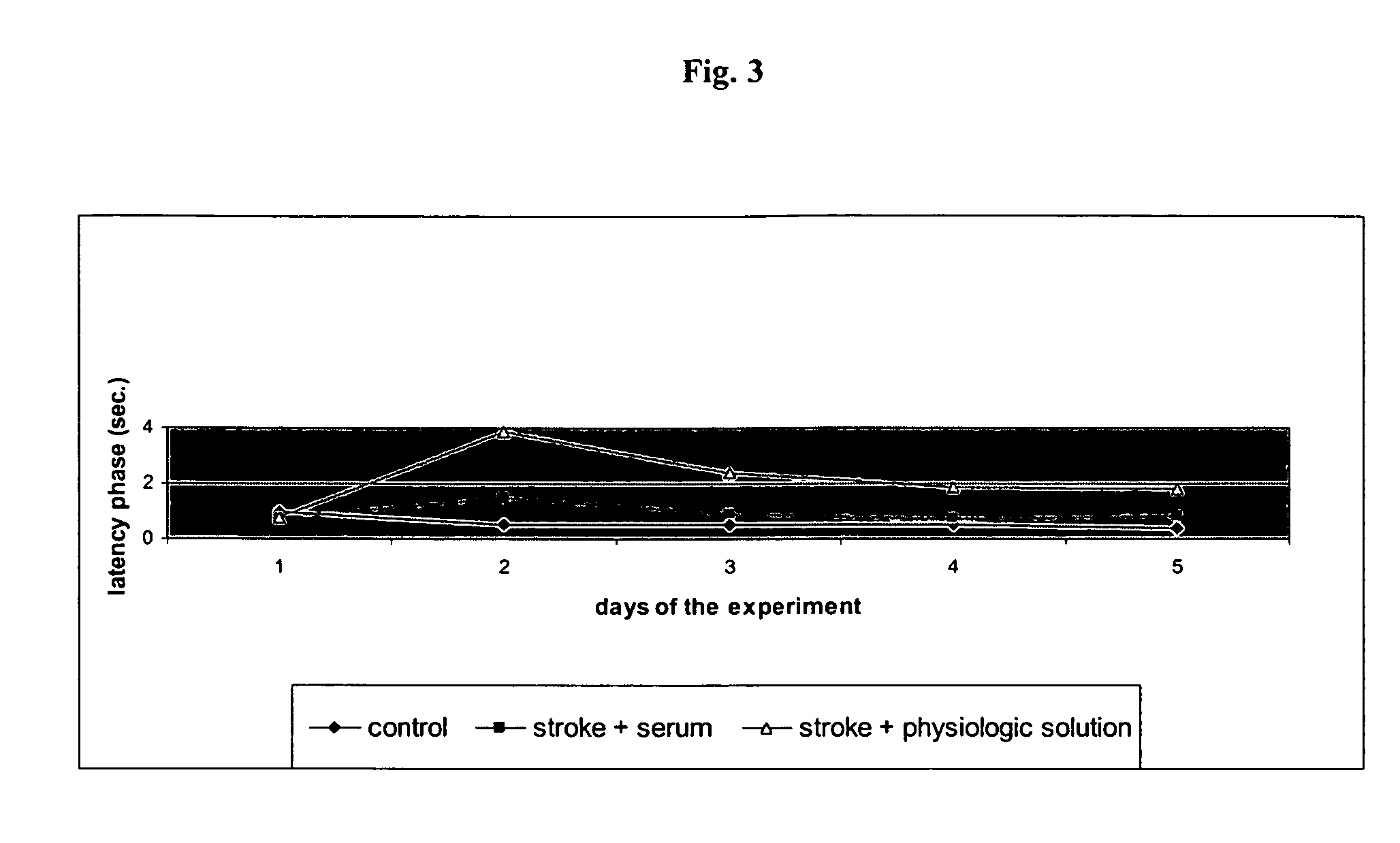Use of a biologically active blood serum for the treatment of stroke
a blood serum and biological technology, applied in the field of use of biologically active blood serum for the treatment of stroke, can solve the problems of stroke putting a burden of $43.3 billion per year on the society of the united states alone, corresponding loss of neurologic function, and increased risk of blood clots in blood that flows slowly
- Summary
- Abstract
- Description
- Claims
- Application Information
AI Technical Summary
Benefits of technology
Problems solved by technology
Method used
Image
Examples
example 1
Method of Obtaining Chicken Blood Treated by Electroshock
[0076]For the preparation of serum from chicken, the chicken were treated with an electroshock of grade II to III (electrical voltage 80-120 V, current 0.05 A, frequency 50 Hz, application time: 3 to 4 sec at the head) in a standard water bath. Blood was then drawn from the arteria carotis and further incubated at a temperature of 4 to 8° C. for 18 to 24 h in polyethylene flasks. After complete retraction of blood clots the flasks were spun at 3.000 rpm for between 20-30 minutes. The serum was separated from the blood clots and lyophilized under art known conditions. The flasks with the lyophilized serum were treated on a RZ-100-M apparatus with 20-30 kGy, preferably at around 25 kGy using 60Co as a gamma radiation source for 3 to 4 h. Typically the dried serum is placed into a paper bag of a size of 70×75×200 mm during irradiation. Radiation strength is adapted to provide about 4.5 kGy / h in the middle of the bag. The treated ...
example 2
Determination of the Effect of biological Active Blood Serum on Experimentally Induced Ischemic Stroke in Male Wistar Rats
[0077]The effects of the biological active blood serum of the present invention on an experimentally induced ischemic stroke in male rats was investigated. To investigate the effect an established animal model of ischemic stroke was used which involved the restriction of the arteria carotis at the base of the skull of a rat. The experiments involved 70 male wistar rats (body weight in the range of 210-240 g) out of which 60 animals were subjected to the artificial induction of an ischemic stroke and 10 were assigned to the control group, which were only treated with a physiologic solution (1 ml intraperitoneal). The animals were obtained from a Russian breeding plant (Stolbowaja of the Russian Academy of Medical Sciences).
[0078]Prior to the experiments 10 rats were placed into standard cages for at least 7 days to accustom them to at libido conditions, i.e. unlim...
example 3
Determination of the Cerebroprotective Effect of Biological Active Blood Serum in a Model of Cerebral Haemorrhage in Rats, with Evaluation of Neurological Deficits, the Impairment of Cognitive Functions, Level of Anxiety and Survival Rate
PUM
 Login to View More
Login to View More Abstract
Description
Claims
Application Information
 Login to View More
Login to View More - R&D
- Intellectual Property
- Life Sciences
- Materials
- Tech Scout
- Unparalleled Data Quality
- Higher Quality Content
- 60% Fewer Hallucinations
Browse by: Latest US Patents, China's latest patents, Technical Efficacy Thesaurus, Application Domain, Technology Topic, Popular Technical Reports.
© 2025 PatSnap. All rights reserved.Legal|Privacy policy|Modern Slavery Act Transparency Statement|Sitemap|About US| Contact US: help@patsnap.com



